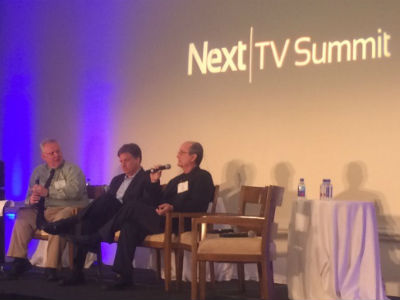Next TV: Disney/ABC’s New Virtualized Reality

Los Angeles -- Thanks to a move away from monolithic, “big iron” infrastructure to much more agile, “virtualized” systems, programmers such as Disney/ABC Television Group will soon be in position to spin up new types of channels that could be made available for a few hours, a few days, a few weeks, or perhaps just around specific events.
That was one of the potential use-case examples cited here Thursday at the Multichannel News/B&C NextTV Summit during a case study about “Project Columbus,” an initiative that Disney/ABC and Imagine Communications kicked off in 2011 to virtualize the programmer’s workflow, master control and playback operations, positioning the broadcaster to support a new IP-based world that now includes streaming players, gaming consoles, tablets and smartphones and is, more generally, altering the way viewers are consuming video.
The initiative, which is global in scope, aimed to “virtualize and get away from big iron broadcast centers that don’t have the ability to scale,” Vince Roberts (pictured above, at right), Disney/ABC Television Group’s EVP, global operations and chief technology officer, said.
Project Columbus, which automates workflows and builds virtualized environments that live in private, hosted clouds “gives us scale, and the ability to move our markets,” he said.
The approach, which allows programmers to run and manage key functions in software on commercial off-the-shelf (COTS) equipment, is gaining momentum among several broadcasters, noted Imagine CTO Steve Reynolds (pictured above, center), as they look for ways to launch more channels at a more rapid clip, and to enter new markets and geographies. It will also put them in a better position to introduce new encoding platforms that will be used for 4K/Ultra HD.
The move to virtualized systems, he told session moderator, Broadcasting & Cable contributing editor George Winslow (pictured, far left), will enable programmers to stand up new channels on an “an ad hoc, on-demand basis.”
“We have to be in a virtual environment to take advantage of an industry on the consumer side that is changing so rapidly,” Roberts said. “I can spin up a workflow in minutes, not months.”
The smarter way to stay on top of the multichannel video marketplace. Sign up below.
“This is not a science experiment,” he added, noting that the project is being rolled out to support Disney Channel and an initial eight ABC feeds later this year.
As for why the timing is right to move away from hardware-based functions, Reynolds said Moore’s Law has finally caught up with what will be demanded of these new virtualized systems. “We’re now at a place that this is finally feasible,” he said.
Roberts acknowledged that the shift also required a cultural shift and much discussion to get everyone on board with the program.
Whether you’re converting to the cloud or changing your business structure, “Everybody needs to buy in,” Roberts said, noting that it also requires “champions deep in the organization” – people he referred to as “change agents.”
“It’s not an insignificant effort,” he said.
